Review of the variety of horizontal juniper "Andorra Variegata"
Horizontal coniferous plants are used for landscaping areas and building compositions in landscape design. Juniper horizontal Andorra Variegata has one feature: it changes the color of the needles at different times of the year, which attracts the attention of gardeners.
What is this plant
Juniper of this species was first seen in Canada and North America. The plant settled in mountainous areas near natural reservoirs. Belongs to the cypress family.
Botanical description
Evergreen undersized, ground cover shrub. It has a cushion-shaped crown, from which branches scatter in all directions. The bush grows slowly, adding no more than 10 cm per year. It grows on any soil, is able to tolerate frosts down to -34 degrees.
What does it look like
It looks like a low, not higher than 50 cm, bush creeping along the ground. The length of its branches reaches 2 meters. The branches are covered with dense and short needles, resembling scales in texture. The needles change color depending on where they grow and on the season.
If the bush is in the sun, then its needles are ashy green, and if in the shade, they are emerald green. When frost sets in, the needles change color to purple-violet. In the spring, when young shoots appear, and they grow from the center of the bush, their color is creamy with a whitish tint. Its fruits are small and inconspicuous, have a bluish-white tint.
Requirements for growing conditions
Get juniper with a beautiful crown and healthy branches and rhizomes, some tricks for caring for the bush will help the gardener:
- The juniper of the Andorra Variegata species loves warmth and prefers sunny places. But it grows well in a small shade.
- He loves loamy soils, it is desirable to choose breathable and well-fed. You can cook it yourself: mix 2 parts of peat and add one each of river sand and turf.
- He does not like a lot of moisture, strong watering can destroy the bush.
- Bushes need to be planted far from each other: from 50 to 150 cm.
- The hole for the bush must be made deep (at least 70 cm) and spacious. At the bottom, lay a drainage layer in the form of sawdust or broken brick.
- It is strictly forbidden to deepen the neck of the bush.
- The first few days after planting, the bush needs to be watered daily. In dry summers, it is also required to regularly irrigate the crown to preserve the needles.
- Before wintering, cover young plants with spruce branches, and adults need to be covered with sawdust with a layer of 10 cm.
In the heat, the juniper cannot be irrigated, the needles may burn out. It is recommended to do the rain on your own only in the evening.
How to plant
Often, the planting of the bush is carried out in mid-spring or early autumn. Before planting, it is necessary to carry out preparatory work to give the soil the desired acidity.
Training
The plant loves sunny places and soil with low acidity. It is best to prepare him a fertile soil with well-permeable moisture. If there is no such soil on the site, then you need to do it yourself.
To do this, mix peat, turf and river sand in the right proportion. Dig a hole twice the size of the earthen clod of the seedling. If there are diseased branches and roots of the seedling, cut it off, and treat the cuts with wood ash.
Landing technology
When planting, it must be taken into account that if the bush is already an adult, then the hole should be at least 70 cm deep.Bushes should be placed at a distance of 50-150 cm. A distance of 2 meters is also allowed. At the bottom of the pit, lay a layer of broken brick or crushed stone, 15 cm thick.
Place the seedling in a hole, spread the roots and branches and cover with soil. Tamp the surface around it. Be careful with the root collar, it should be on the surface, at a distance of 5-7 cm from the ground. Water the seedlings every day for a week.
Juniper care
Care features should be studied in advance to ensure comfortable growth of the bush. Timely watering and feeding makes the needles bright and durable.
Watering
Juniper is a drought-resistant plant, therefore it does not require regular watering. Watering should be done if the weather is hot and dry for a long time. Sprinkle once a week in the evening. Take for this only settled water with ambient temperature.
Do not spray the plant with cold water.
Top dressing
Often no top dressing is required. One time is enough for him, which needs to be done in the spring. It is better to use fertilizers for conifers. It is categorically impossible to use organic matter. Dilute fertilizers strictly according to the recipe indicated on the package.
Juniper poorly tolerates excess nutrients. Fertilize while watering, so as not to burn the delicate root system of the plant. Apply the top dressing carefully so that the solution does not get on the branches and trunk of the bush.
Mulching
It is imperative to do mulching: it prevents moisture evaporation and crust formation, prevents weeds from growing and prevents roots from freezing in frost. To do this, you can use sawdust, fallen needles, peat, expanded clay, wood chips and pine bark. After winter, it is imperative to replace the old layer with new mulch.
Loosening
It is imperative to loosen young seedlings, adults do not need it. Loosening is carried out after watering and weeding. This should be done shallowly, because the roots of the plant are high. Loosening is done around the bushes with care so as not to damage the crown. Thus, the soil is saturated with oxygen.
Pruning
Before the start of sap flow, in early spring, it is necessary to prune the bush. Dry, damaged and frozen branches are removed. After that, you need to feed the plant and spray it with a fungicide solution so that the branches grow evenly and protect it from infection.
When pruning, you should protect yourself from toxins that are secreted by the branches of the plant.
Formation
Also in the spring, a bush is formed. You need to cut the branches with a sharpened knife, pruner or garden shears. By cutting off unnecessary parts of the branches, you can change the direction of their growth. Thus, the formation of a beautiful shape of the crown of the shrub is produced.
Preparing for winter
Only young bushes are required to cover for the winter. Spruce branches, agrofibre or burlap should be used as insulation. Adult plants need to be mulched with a layer of 15-20 cm of peat around the trunk. During the winter, care must be taken to ensure that the snow layer does not break the branches. A high layer of snow is removed from the plant.
Diseases and pests
Of the pests, the spider mite, coniferous aphid, scale insect and shoot moth attack the juniper most of all. Chemical preparations effectively help to fight these insects: Fitoverm, Flumayt, Talstar. Sometimes the plant is affected by root rot. It develops from excess moisture, so you do not need to be zealous with watering.
The most common disease that often affects juniper is rust. The affected plant is immediately visible by the yellowed needles. Infection can be prevented if infected twigs are removed in a timely manner and preventive treatment with preparations with copper is carried out in the composition: "HOM", "Skor", "Fundazol".To avoid infection, you should not plant bushes next to fruit crops, which are the source of damage.
Reproduction
Getting new juniper seedlings is very important for gardeners. Having grown one bush, they strive to get more in order to use seedlings in the design of their site. All coniferous horizontal shrubs reproduce in three ways: by seeds, cuttings and layering.
- The first way is by seeds. The juniper fruit contains several seeds. From ripe fruits, seeds must be removed and planted in a small greenhouse. Seedlings will appear soon. The sprouts develop and grow very slowly. To transplant such a seedling into the ground, you need to wait 3 years.
- The second way is by cuttings. You need to take cuttings in April or early May. To do this, it is better to choose a bush that is about 10 years old. Cut off the upper, not stiff shoots 25 cm long. Remove the needles and bark with a sharp knife at a distance of 4-5 cm from the lower end. Keep the growth stimulating solution in the solution for several days. Plant the cuttings in the pre-prepared soil that the juniper needs, ensuring drainage.
The cuttings should be at an angle to the soil surface. Place the dishes with cuttings in a place where direct sunlight does not fall on it. The light should be diffused. Next, you need to regularly water the cuttings, but do not overflow. Wait until spring and transplant the seedlings to a permanent place of growth. - The third way is layering. Choose a suitable branch with young shoots and dig it into the ground, secure it with special pins. This place is constantly watered and sprinkled with earth. When the cuttings give roots, it must be carefully separated from the mother bush and transplanted to a permanent place.
How it is applied in landscape design
Amateur flower growers actively use creeping juniper in landscape design. It looks impressive both on an alpine slide and on the details of a rocky garden. With the help of juniper, you can create a picturesque landscape on retaining walls, slopes, forest edges and coastal embankments. The decorativeness of the plant is preserved all year round: beautiful needles look harmoniously with flowering varieties and against a background of white snow.
It is often used to decorate continuous flowering flower beds. In this case, the juniper is planted in the foreground. If used in rock gardens and Japanese gardens, it is better to plant it on the edge of retaining walls. A great combination if planted next to heather or roses.
In the shade of a juniper, the needles grow dull, so it is better not to plant it next to trees or tall shrubs.
Plant transplant
Juniper does not like transplanting to another place, so initially you need to plant it correctly. Sometimes the place is chosen too shaded or sunny and the owner wants to transplant it. How to do it painlessly for the plant:
- It is better to carry out the procedure in early spring - late March or early April. At this time, it takes root well in a new place due to sufficient moisture after winter.
- It is necessary to prepare a place in advance and dig a hole there. Cut the turf around it with a shovel and let the pit stand for 3 days. After replanting the bush, you need to mulch around the trunk, after watering it. Shade the bush so that the crown does not burn out, and you can remove the shelter only in June. To increase the vitality of the roots, it is necessary to water the bush not abundantly, but regularly.
- If an autumn transplant is required, then it is done in September a month before frost and in cloudy weather. Sprinkle mulch around the trunk and water sparingly until frost.
If you do everything right, the juniper will live and flourish for a long time. It will perfectly decorate the landscape of a garden plot or estate and will delight the eye with a change in the color of the needles.
Reviews
Everyone who has used this juniper variety in the design of their site speaks only positively about it.This is an unpretentious plant that quickly recovers in the spring and pleases the eye with its variegated colors. It harmoniously fits into any composition and perfectly strengthens the soil on slopes and depressions.
The only drawback is that he likes lighted areas, which is not always possible to choose in small areas of gardeners planted with large trees and fruit bushes.
Watch a video about horizontal juniper in the garden:



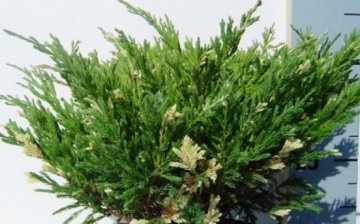
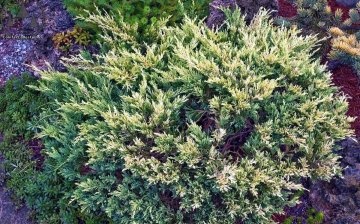
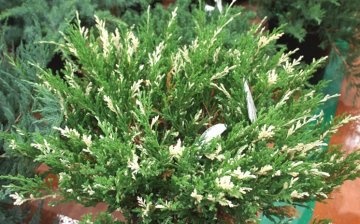



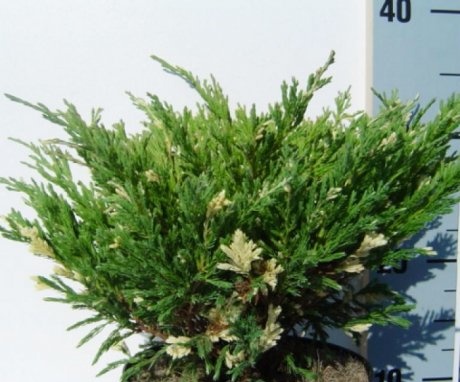
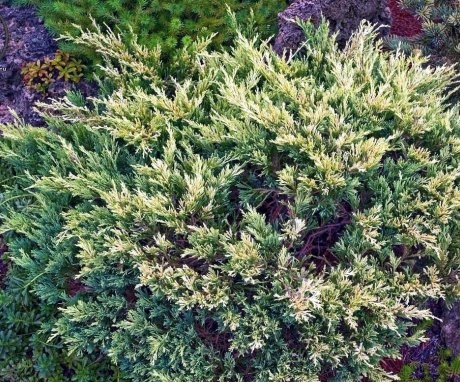
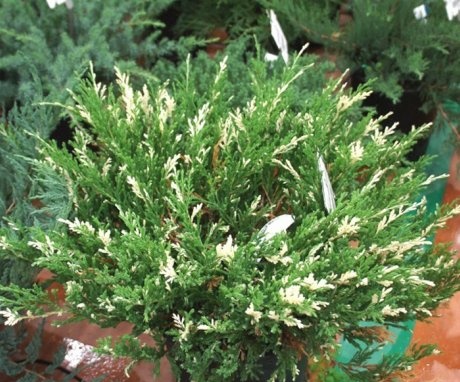
I love the smell of this plant, unfortunately now there is no way to grow it in my garden. There is simply no open space. I tried to plant a plant on the windowsill, not very successfully, there is clearly not enough light.